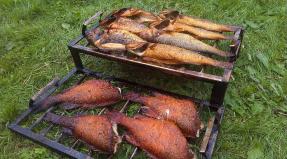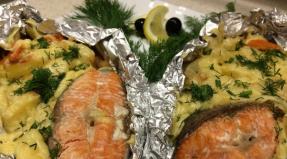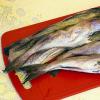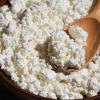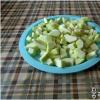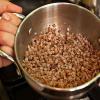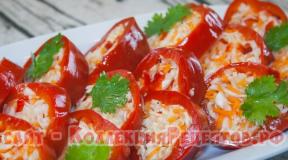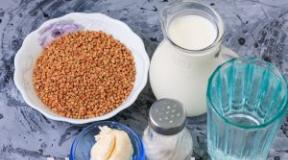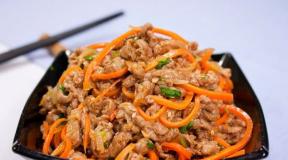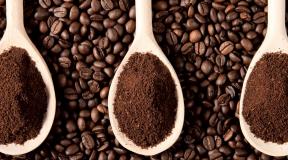Scrabble. Great writer and excellent cook - Alexandre Dumas
French cuisine is world renowned. The city is considered the culinary capital of France. But in all corners of this country there are dishes that are truly proud of. We offer you to get acquainted with the most famous representatives of the French culinary tradition.
Cassoulet
This traditional dish from the region is made with white beans and meat. The dish got its name from the name of the terracotta dish (kassol) in which it was cooked. According to legend, cassoulet appeared in the city of Castelnaudary during the Hundred Years War (1337 - 1453). During the siege by the British, the inhabitants of this city were forced to cook together from everything that was left in stocks in order to feed their defenders. And there were beans and meat. A beautiful version, which, however, is refuted by historians, because beans appeared on the European continent only in the 16th century. If the dish was cooked, then, most likely, from beans. This story highlights the characteristics of the dish: it is made from leftovers and is very nutritious.

Ragout of white veal meat with white sauce - blanquette de veau
A traditional French dish of boiled veal, carrots and white sauce. It got its name from the white color of the sauce (in French "blanc"). In principle, any white meat (turkey, chicken, rabbit, pork) can be used to prepare this dish. But it is veal that is considered classic. A well-known literary character - Commissioner Maigret - was a lover of this stew.

Ratatouille
A typical dish of Provencal and cuisine. Initially, ratatouille was called a stew of prefabricated vegetables. "Rata" in military jargon meant a mixture of beans and potatoes, then various vegetables, bread and meat. The classic ratatouille recipe features eggplant, zucchini, bell peppers and tomatoes, onions, garlic and olive oil. There are two methods of preparing this dish: all vegetables are cooked at once together or each separately. Usually ratatouille is served as a side dish, but it can also be an independent dish.

Frog legs - cuisses de grenouilles
Frogs are eaten not only in France, but it is in France that, according to statistics, they are eaten the most. And the closest neighbors of the French - the British, and after them the rest of the world - call them frogs (Frog-eaters, froggies). Frogs appeared on the tables of the French elite in the 16th century. There are many ways to cook and serve, such as with garlic sauce and parsley.

Croque-monsieur sandwiches
The title translates as "Eat Man". This is a type of hot sandwich with ham and (most often the Emmantal variety), fried in a pan or oven, or in a special apparatus. It seems that for the first time such a sandwich appeared in 1910 in the menu of one of the Parisian cafes on the Boulevard des Capuchins. The origin of the name is unknown, several versions are put forward, according to one of which the cafe owner Michel Lunarka, who invented this sandwich, started a joke that there was human meat in the sandwich. The fact was that his new cafe became very popular very quickly, and competitors, wanting to spoil Michel's reputation, spread the rumor that he was a cannibal. On the birthday of the sandwich, the cafe ran out of baguette, and the sandwich was made on bread. When the customer asked what kind of meat was inside, this was the answer.
One of the varieties of the sandwich is “Eat Woman” (Croque-madame), fried eggs are placed on top of it.

Potato casserole - gratin dauphinois (gratin dauphinois)
Traditional French dishes from the Dauphine region. The first official mention of it was recorded in 1788 in the description of a dinner given to the officers of the city of Gap by the Duke of Clermont-Thonaire Charles-Heinrich, who at that time served as Lieutenant General Dauphine. To prepare this dish, a special type of potato is chosen, always yellow and well-boiled. Garlic, milk/cream or sour cream is added to the dish.

Beef Bourguignon - boeuf bourguignon
This is a representative of the kitchen. Prepared on red Burgundy wine, with the addition of mushrooms, onions and lard. There are numerous options for combining meat with a side dish. It can be potatoes, carrots, green beans, pasta. Initially, it was a festive, then Sunday dish of the Burgundian peasants.

Braised beef with vegetables - pot-au-feu (pot-au-feu)
One of the emblematic dishes of French cuisine. This is a dish of long-cooked beef broth flavored with vegetables and herbs. To prepare the dish, invaluable pieces of beef are taken (they require a long preparation, hence the long cooking time): shank, cheeks, thighs, shoulder blades, etc., as well as pieces with cartilage, vegetables (carrots, turnips, leeks, potatoes, celery , onion) and spices (herbs, black pepper, cloves).

Pie in Lorraine - quiche lorraine (quiche lorraine)
A variant of the savory pie from the kitchen. It is prepared from shortbread or puff pastry, from eggs and bacon cooked with sour cream. The pie is recommended to be eaten hot. A very popular dish in France, which can be easily found even in a bakery.

bouillabaisse
Traditional Marseille dish. This is a fish soup that is eaten with croutons smeared with garlic oil. This dish was prepared back in Ancient Greece at the time when it was just founded (7th century BC). It was the food of the common people, fishermen and peasants. The fish that remained at the bottom of the fishing nets came across in the soup. And today it is a "serious" dish: the fish is cooked in a broth with the addition of wine, olive oil and even saffron. Bouillabaisse is served twice: first as a broth with croutons grated with garlic and a special sauce; then like a fish. Fish species traditional for bouillabaisse, which should be perfectly fresh: sea ruff (la rascasse), sea dragon (la vive), dory (le saint-pierre), sea eel (le congre), sea bream (la daurade), marlin (le merlin), monkfish (la lotte de mer), gurnard (le grondin). In Marseille, there is even a "Charter bouillabaisse" - this is a detailed classic recipe to keep the dish unchanged. In fact, there are also unscrupulous restaurateurs who, under the name buaybes, sell any fish soup. Tourists need to be on their guard, especially in restaurants near the old port.

Rooster in wine - coq au vin
A classic French dish that appeared during the conquest of Gaul by Julius Caesar. According to legend, the head of one of the Gallic tribes, in order to make fun of the Romans besieging him, sent them to the emperor a rooster - a symbol of the courage of the Gauls. In response, Caesar invited the Gaul to dinner, during which a rooster cooked in wine was served. Traditionally, the dish is prepared from a rooster (or chicken) cut into pieces, small onions, garlic cloves, bacon, good quality red wine, herbs, carrots, mushrooms, parsley. As a side dish, boiled potatoes or pasta are served with it.

Fondue
This is a Savoyard dish made from melted cheese and bread. It is made with cheeses produced in the region: Comté, Beaufort, Savoy Gruyère or Savoyard Emmantal. Together with the rapid development of alpine tourism in the 1950s. Fondue becomes popular throughout France. Eating fondue is a whole ritual. Small pieces of bread on special long forks are dipped in cheese melted in white wine. Cheese melting takes place in a special saucepan, which is heated from below.

Burgundy snails - escargot (escargots de Bourgogne)
Traditional snail dish helix pomatia. Prepared for family holidays and Christmas. Man has been eating snails since time immemorial. Helix pomatia snails are found in eastern France and central Europe. In France, up to 30 thousand tons of snails are consumed annually. It should be noted that in view of the threat of extinction of snails in France, a law has been passed to protect them, regulating the collection of this animal. The snails are baked in their house with garlic butter and chopped parsley. They are served in a dozen or 6 pieces with special devices.

Foie gras
The famous holiday dish. Prepared from duck or goose liver, birds are specially grown and fattened. France is the largest producer and consumer of foie gras. The technology of fattening poultry for the production of liver was invented in Ancient Egypt, transferred to Ancient Rome through Ancient Greece. After the fall of the Roman Empire, the production of foie gras remained in the Jewish communities, as Jews used the liver for frying (it was forbidden for them to fry meat in butter, and olive oil was difficult to obtain). Now foie gras is a traditional dish of the festive feast. Usually served cold and as an appetizer.
Making an excursion into the history of cooking, in an endless series of dish names, you can find the names of famous writers. The great chefs of the past named their culinary masterpieces after the writers, and some dishes received a “literary name” because they were preferred by gourmet writers.
The great culinary specialist of the last century, Auguste Escoffier, liked to give his dishes the names of famous personalities, including writers. In his "Culinary Guide" you can find beef Saute “Tolstoy”, scrambled eggs  tunya “Balzac”, jelly “Maupassant” and etc.
tunya “Balzac”, jelly “Maupassant” and etc.
Charles Ranhofer, chef at the iconic Delmonico restaurant, prepared for Charles Dickens' visit to New York in 1867 “veal pie a la Dickens” and “beet pancakes a la Dickens”.
The menu of his restaurant also included "Dumas salad".
The signature omelette by Chef Jean Baptiste Virlogeux of the London restaurant Savoy was named after the English writer Arnold Bennett (you can see the recipe for its preparation here).
And do you know that dessert in the form of tubes with whipped cream or cream in Austria they call ... " Schiller's curls” (Schillerlocken)?

Such an unusual name is associated with a portrait of Friedrich Schiller, painted by the artist Anton Graff in 1786. Copies and engravings from the painting were widely distributed at the end of the 18th century and gave the name to the popular dessert. Now this portrait is in the Dresden Kügelgenhaus Museum.
Now we offer you 3 prescriptionnamed dishes, from which you can make an original “literary lunch” with dessert.
1. Yokai soup
bean soup"Jokai" got its name in honor of the classic of Hungarian literature Mora Jokai (1825 - 1904). A popular novelist and one of the most influential figures in Hungarian literature of the 19th century, he wrote more than 110 novels, short stories, plays and poems during his long creative life. The most famous in his heritage are “Hungarian nabob”, “Zoltan Karpaty”, “Sons of a man with a stone heart”, “Nameless Castle”, “Golden Man”. His short story "Saffy" formed the basis of the operetta "The Gypsy Baron" by Johann Strauss.
At home, Mor Yokai is known not only as a literary classic, but also as a fine connoisseur of good cuisine. Yokai's wife, the famous dramatic actress Róza Benke Laborfalvi, loved to cook and often pampered her husband and his guests with hearty and delicious meals. One of Mora Yokai's favorite dishes was a soup made from beans according to a special recipe. It was this soup that got the name of the writer.
The recipe for Jokai bean soup is taken from the Small Hungarian Cookbook by Karoly Gundel, the founder of Magyar cooking. His cookbook became a bestseller and went through 40 reprints in 20 languages.

Yokai Soup Ingredients
”:
180 gr beans
300 gr smoked sausage
smoked pork leg - 1 pc.
1 medium onion
1 st. l flour
3 tbsp pork fat
3 gr paprika
1-2 carrots
1 tomato
150 gr green pepper
150 gr sour cream
parsley root, bay leaf
Garlic to taste
30 gr chipette ( homemade soup dough)
Rinse the beans thoroughly and soak overnight. Pork leg pour about 1.5 liters of water and cook until it becomes completely soft.
The next day, remove fat from the surface of the broth in which the leg was boiled and fry in it.
sliced carrots and parsley root. Add beans to them (along with the water in which they were soaked) and the broth in which the pork leg was cooked. Season with bay leaf, a little garlic, finely chopped green pepper and tomato and cook with the lid closed. Salt, as a rule, is not necessary, because. smoked pork broth is very salty.
Fry the sausage and cut it into thin circles. In sausage fat, make a white dressing, add finely chopped onion and, at the last moment, paprika. Pour the dressing into the soup when the beans in the soup are soft.
Mix sour cream with a spoonful of flour and add to the soup, then put the cap and sausage circles in the same place. Let it boil again.
Before serving the soup, cut the meat from the pork leg into small cubes and arrange on plates.
If the soup is too sour, you can add a little sugar to it.
Chipetka ( homemade soup dough )
 Title chipette test comes from the Hungarian word “chipkedni”, which means - tweak. To prepare such a dough, you will need 80 grams of flour, 1 egg and salt.
Title chipette test comes from the Hungarian word “chipkedni”, which means - tweak. To prepare such a dough, you will need 80 grams of flour, 1 egg and salt.
Knead a stiff dough from flour, eggs and salt (without water). Roll it out on a floured board into a sheet about 1 mm thick, then pinch off shapeless pieces about the size of a fingernail from it with floured hands. Boil these pieces in a boiling soup. When the chips are ready (after 3-4 minutes), they float to the surface.
(More about personalized soups can be read).
The Chateaubriand steak is named after Viscount Francois Rene de Chateaubriand (1768 - 1848), a writer and diplomat who entered the literary pantheon of France as the first representative of romanticism. The influence of Chateaubriand on French literature is enormous (“ I want to be Chateaubriand or nothing once proclaimed the young Victor Hugo).
The “father of romanticism” got into the history of cooking thanks to the juicy steak named after him. There is a legend that recipe beef steak invented by the viscount's personal chef in 1822, when Chateaubriand served as ambassador to London.

According to legend, the steak was prepared by frying several steaks stacked one on top of the other over an open fire. When the outer steaks were charred, they were simply thrown away. This method ensured that the steak cooked evenly and retained its juiciness. It is interesting that such a recipe was used - a brilliant artist and, moreover, a skilled chef.
Served with Chateaubriand steak sauce from white wine, demi-glace, shallots, lemon juice and tarragon, also called “chateaubriand”, and as a side dish - oval-shaped potatoes no larger than an olive (!), fried in oil.
Now Chateaubriand is prepared from a large piece of tenderloin up to 1.5 kg, which is served whole and slices are cut off from it already on the table. The second cooking option is a piece of beef tenderloin at least 5 cm thick (“ two fingers”) are fried in a very hot pan for 2 minutes. on each side, and then bring to readiness in the oven. Before cooking, the meat can be marinated in olive oil with a little pepper for several hours.
3. Cake (cake) Runeberg

Cake or Runeberg cake - traditional Finnish dessert in the form of a cylindrical cake with sugar icing and raspberry jam. It got its name in honor of the Finnish national poet Johan Ludwig Runeberg (1804–1877). He entered the history of Finnish literature as an epic and lyric poet, and the author of the national anthem. During his lifetime, he became the first great man of Finland. Runeberg's popularity is so widespread that the poet's birthday on February 5 is celebrated as a national holiday.
There is a legend that the recipe for the popular cake was invented by the poet's wife, Frederika, although back in the 18th century, a similar dessert was prepared by confectioner Lars Asterius from the city of Porvoo. However, for the first time a cooking recipe runebergintorttu was published in 1850, in a book of home furnishing advice written by the poet's wife. Johan Ludwig Runeberg himself considered the cake of his name to be the best breakfast and always supplemented it with a small glass of fragrant Finnish liqueur Punssi.
Runeberg cake recipe
 Ingredients
:
Ingredients
:
1 egg
75 gr sugar
100 gr butter
50 ml cream
200 ml flour
1 teaspoon baking powder
50g chopped almonds (or walnuts)
1 teaspoon vanilla sugar
1 teaspoon Amaretto liqueur
Traditionally, cakes are baked in a special form in the form of a cylinder with a diameter of 5 cm and a height of about 6-7 cm. Alternatively, cake pans 5 cm in diameter and 5 cm in height.
Melt the butter and let it cool down a bit. Whip cream to soft peaks. Beat eggs with sugar, adding liqueur, melted butter and whipped cream.
Mix the dry ingredients and, adding to the butter - egg mass, knead the dough.
Lightly grease muffin tins and pour batter into them. Place the molds on a baking sheet and bake the cakes at 175 - 200°C for 15 - 20 minutes.
While the cupcakes are baking, make sugar syrup with 100ml sugar, 50ml water and 1 to 2 tablespoons of rum or cognac.
Mix raspberries and sugar (100 g raspberries - fresh or frozen and 50 g sugar), bring to a boil and simmer for about 15 minutes. The mixture should be thick. You can use ready-made raspberry jam.
Prick the finished cupcakes with a toothpick and fill with warm syrup. Leave for 1-2 hours for the syrup to absorb.
Using a teaspoon, cut a small indentation in each cake, filling it with raspberry jam and decorating with a circle of icing sugar.
47 chose
"Porthos looked at the bottle standing next to him, hoping that he would somehow dine with wine, bread and cheese, but there was no wine - the bottle was empty ..."
/BUT. Dumas. "Three Musketeers"/
As a child, when I imagined the scene of Porthos's dinner with the Koknar couple, I was very sorry for the brave musketeer who remained hungry. Wine in those days did not interest me, and cheese and bread seemed too mundane. Now I would gladly agree to such a meal - provided, of course, that all its components are French ... Noble French cheeses have already been the topic of our culinary journey, a wide selection of wines deserves a separate discussion, and bread ... Ah, this French baguette is fragrant, with a crispy crust and a tender crumb - how to bring it untouched from the shop?! But I got distracted...
So French food. These words say everything and say nothing. What do we imagine when we talk about it? Onion soup? Frog legs? Foie gras? Sophistication and perfection in everything - both in cooking and in serving dishes, honed over the centuries? Let's start with the fact that there is no single French cuisine ... There are many regional variations (cuisine regionale), there is a "regular" or "common" cuisine (cuisine bourgeose) and, of course, high cuisine (haute cuisine), the founders of which were the chefs of the French kings. The division, however, is very arbitrary - dishes easily "migrate" from one category to another. So, the famous Marseille bouillabaisse has gone from an unpretentious dish of fishermen to a masterpiece of culinary art. And, of course, there are features that are typical for any version of French cuisine. One of them is sauces.

For me, sauce is the essence of French cuisine. This is not just an addition to food, it is an elegant touch, a final flourish that turns a good dish into a true masterpiece. Properly prepared sauce is designed to emphasize, set off, but in no case change the taste of food! There is a saying: ""The architect hides his mistakes under ivy, the doctor - in the ground, and the cook - under the sauce" (it is attributed to Bernard Shaw). There is some truth in it, but it is the share - no sauce will make a bad dish good, but here "medium" can significantly improve. I'm not even talking about attempts to disguise "second freshness" sturgeon under a spicy sauce - there is no place for this in a decent kitchen! A familiar dish served under various sauces begins to play with new shades of taste and aroma. - it's so exciting!
The sauce has another important role. Beautiful presentation of a dish is an indispensable part of French cuisine, and sauces play into the hands of the chef. If the sauce is served separately, then an elegant gravy boat will add the right note to the serving. Do we often use gravy boats that are in our services, inherited from mothers and grandmothers? I am afraid that many people ignore this serving item - and completely in vain!




If the dish is served with sauce, then the scope for the chef's imagination is even wider. French chefs manage to create real paintings on a plate, "revitalizing" appearance dishes bright spots of multi-colored sauces. Sometimes such beauty is even a pity ...



How many sauces does French cuisine know? There is no answer to this question - after all, new ones appear every day. The French statesman Talleyrand is credited with the following words: "In England there are 360 religions and 3 sauces, and in France - 3 religions and 360 sauces." However, some claim that the British said it. But what difference does it make if the meaning is clear - there are many sauces in France, and much more than 360. Experts number about 3000. It is impossible to tell about all of them, but here the history of French cuisine comes to our aid.
In the XVIII century, France becomes a trendsetter in culinary fashion and consolidates its position in the next century. Not only European royal courts, but also more or less rich and noble people strive to have a French chef. It was in those days that "classic" French cuisine was born, and sauces take their rightful place in it. An important role in the classification of sauces was played by the "king of cooks and the chef of kings" Marie-Antoine Karem, who served with Talleyrand, Rothschild, King George IV of England and (albeit briefly) at the court of Alexander I in Russia. The traditions of the "haute" cuisine of Carem in a more modern version were continued by the no less famous Georges Auguste Escoffier, who worked in famous restaurants in Paris, Cannes, Monte Carlo and London. He published the best-selling "Cooking Guide", where sauces are given a significant place.
|
M.- A. Karem |
J.O. Escoffier |
I present to you (according to the classification of the great chefs of the past) the main sauces of French cuisine. They are also called "basic", and Karem called them "great" or "mother", since many others can be prepared on their basis.
Sauce "Bechamel" (bechamel). This is probably the most famous, most versatile and not at all difficult to prepare sauce. Like all dishes "with history", "Bechamel" has several versions of origin. One of them says that the court chef of Versailles Varennes came up with the sauce, but the name of the dish was named after the Marquis de Bechamel.
To prepare the bechamel sauce, we need:
- ½ l milk
- 50 grams of butter
- 50 grams of flour
- Salt, white pepper, grated nutmeg to taste
Melt butter over low heat, add flour, stirring constantly. This will be the base of the sauce, called roux in French. Remove from heat, add cold milk to the hot base, rubbing until completely smooth. Put on low heat again, cook with constant stirring until boiling and a few more minutes. Add salt and spices.
The main difficulty, in my opinion, is to achieve complete homogeneity of the sauce. If not, then it can be filtered through a strainer.

"Bechamel" is great for light meat, chicken, lasagna, potato, vegetable and mushroom casseroles. And this sauce also opens up wide scope for culinary experiments - you can add various spices, herbs and many other products to it. A wonderful sauce is obtained if you add onion fried to a golden color to the "Bechamel". Grated cheese (preferably several different varieties), yolks and cream will turn Bechamel into Mornay sauce, ideal for pasta and seafood, and chopped shrimp with cream into an exquisite Nantua ...

Sauce "Dutch"(Hollandaise) is another masterpiece of French cuisine that has nothing to do with Holland.
For the Hollandaise sauce you will need:
- 2-3 yolks
- 250 grams of butter
- 2 teaspoons lemon juice (you can replace half with wine vinegar)
- Salt, pepper to taste
According to the classics, the sauce is prepared in a water bath, but you can just beat it with a mixer (although the first method makes the sauce more tender). Beat the yolks with salt in a water bath, then gradually add the butter, pour in the lemon juice and add the pepper. The main difficulty is that the yolks should not overheat and curl. If the sauce is too thick, you can add some warm water. "Dutch" sauce is prepared immediately before serving and is not stored.

There is another option - using proteins, which are beaten separately and added to the finished sauce. This "Dutch" is more airy, and it can also be stored and even warmed up. Hollandaise sauce is great with vegetables (especially asparagus), fish and seafood, and eggs (like the famous eggs Benedict).

There are many variations on the theme of Hollandaise sauce. If we add shallots and tarragon to it, we get a wonderful "Béarnaise", ideal for steak, and Dijon mustard will turn it, respectively, into "Dijon". Mayonnaise, by the way, is also a relative of Hollandaise sauce. There is a legend that the well-known mayonnaise was born on the island of Menorca, where, during the siege, the French chef ran out of butter, and he came up with an olive-based sauce. Homemade mayonnaise is a wonderful sauce, high-calorie, of course, but very tasty ... You can also cook "Tartar" by adding herbs, pickled gherkins, capers and mustard to mayonnaise, or "Remoulade" - with herbs, capers, spices and anchovies. These sauces are very good with seafood, vegetables and meat.

Velute sauce (veloute) has been known since the middle of the 16th century and exists in several varieties - depending on the broth - base. The broth (weak and light!) can be made from veal, chicken and fish, and it is thickened with the same roux base that we mentioned in connection with Bechamel.
It is prepared in the same way as Bechamel, but instead of milk, broth is used, which is added hot to the base. Very easy and very tasty, try it! In its pure form, the sauce is served with poultry and fish, and it can also be used as a base for soups.

On the basis of "Velute" you can cook a wide variety of sauces. The most famous of them, perhaps, is "German" (allemande). Interestingly, during the First World War, the patriotic French abandoned this name (but not the sauce itself!) The sauce is prepared by adding yolk, cream and lemon juice to the "Velute". Fish "Velute" is often added with white wine, shallots and butter, while chicken - cream and fried mushrooms. Try experimenting with different herbs and spices and I'm sure you'll find yours!


"Spanish" sauce (Espagnole) is a representative of the family of dark, or brown, sauces. Its features are a strong dark broth that is boiled from veal, beef and bones, and a base of butter and flour is fried until brown. According to legend (this sauce also has it), its author was a Spaniard chef who came to France with Anna of Austria.
To prepare "Espanyol" you need:
- 1 liter strong broth
- 50 grams of butter
- 50 grams of flour
- Salt, pepper to taste
- Tomato paste or tomato puree - 1-2 tablespoons
Add flour to melted butter and fry until brown with continuous stirring. Mix with tomato paste, add warm broth, and cook for at least 4 hours over low heat. The sauce should not boil and, of course, burn. Often sauteed onions, carrots and celery, various spices and herbs are added to this sauce.
The preparation of "Spanish" sauce is a long and troublesome process, but it can be done in large quantities ah, and then freeze, which does not affect the taste at all.

This sauce is rarely used in its pure form, creating others based on it. You can explore your options by trying different combinations of spices, herbs and spicy vegetables, adding red or white wine, bacon or mushrooms. And you can turn to numerous recipes - Hunter, Pereguet, Robert, Lyon ... These sauces are perfect for meat dishes.

And, finally, tomato sauce, which for some reason I want to attribute to Italian or Latin American cuisine. But he became one of the main sauces with the light hand of Escoffier at the beginning of the 20th century and became an integral part of the national cuisine of France. You can, of course, buy tomato sauce in the store - the benefit of the assortment of modern supermarkets allows this. And you can cook it yourself, which I have been trying to do lately. The technology of its preparation is not at all complicated, it just takes time, so I make it "on an industrial scale" and store it in sealed jars in a cool place.
The main tomato sauce is simply stripped down puree of fresh and ripe tomatoes with olive oil, salt, garlic and other spices. By the way, spices (except those that can be chopped) are best added to the sauce in a bag towards the end of cooking. How good is tomato sauce? First of all, space for creativity - it goes well with herbs and herbs (try the Provence ones!), with vegetables, olives, mushrooms and cheese ... By adding minced meat, we get the classic "Bolognese", and with cream the sauce turns into a delicate tomato-cream … This sauce and its derivatives are indispensable for pasta, pizza, potato and other vegetable dishes, meat (especially chopped), fish and seafood.

Of course, the "mother" sauces, and even those based on them, do not exhaust the richness of this page of French cuisine. There are whole families of wine sauces and sweet sauces, as well as salad dressings (the most famous of them is Vinaigrette). But, as they say, you can not embrace the immensity ...

I confess - for a long time sauces remained a "secret with seven seals" for me. It seemed to me that it took too long to cook them, it was difficult, and in general, you can do just fine without them. But as soon as I started, I can’t imagine how I managed without these elegant culinary additions that so diversify the usual cuisine. And how interesting it is to experiment with ingredients, creating your own author's sauces! Some of the great French chefs (either Brillat-Savarin, or Dumas-père) are credited with the statement that it is impossible to learn how to cook sauces - you need to be born with this talent. With all due respect, I disagree! There would be a desire.
How do you feel about sauces? Is it customary to cook them in your house?
Svetlana branch , specially for Etoya.ru
Photo: mebelramka.ru, msk.lookmart.ru, luzana.ru, ru-gold.ru, azurworld-rossia.ru, vkysnoemenu.com, turist-mira.ru, abc8.ru, discoveric.ru, sharemykitchen.com, amasauce.fr, simplyrecipes.com, videojug.com, fr.wikipedia.org, kitsapcuisine.com, marsupialkitchen.com, escoffierathome.com , recettesduchef.fr, recettessimples.fr, ediblecommunities.com
5461
D For a long time, France remained a trendsetter in culinary fashion. French cuisine is very subtle and poetic. Therefore, it is not surprising that the outstanding Alexandre Dumas, writer, historian, public figure, was also a brilliant connoisseur of culinary arts and a cook. “The friends of Mr. Dumas assure,” the publicist Octave Lacroix wrote in 1865, “that when he agrees to move from his office to the kitchen or pantry and part with a pen for the sake of a pan handle, you will not find a cook in all of France better than him.” ".
The last book that came out from the writer's pen was the "Great Culinary Dictionary", which contains almost 800 short stories on culinary topics. It is known that the book includes recipes for five types of Russian jam: from roses, pumpkin, radish, nuts and asparagus, which Dumas learned from the Astrakhan Armenians. The dictionary was completed by Arnold Frans after the author's death.
To this day, this book takes pride of place on the kitchen shelf of any enlightened Frenchman. Fascinatingly written, with an incredible amount of useful tips that apply to modern cooking. May you be lucky to acquire this dictionary and replenish your culinary library with a valuable copy.
Alexandre Dumas (known as Father Dumas) was born on July 24, 1802. The famous writer was a remarkable culinary specialist. He took great pleasure in preparing inimitable French salads, sauces and other dishes. In 1858 he undertook a journey through the Caucasus. Dumas subsequently described his impressions in detail. And for the French gourmets, he wrote down in detail the recipe for the dish that he especially liked: “They take lamb, best of all, the sirloin, cut into even pieces the size of a nut, put for 15 minutes in a marinade consisting of vinegar, onion, pepper and salt. this time you should prepare a bowl of charcoal on which you fry the meat.Remove the meat from the marinade and put it on an iron or wooden rod interspersed with onion rings.The meat must be fried on all sides, constantly turning the skewer.If you want your kebab to be very spicy ", leave the meat in the marinade all night. If you don't have a skewer handy. You can use a ramrod. By the way, I use my carbine's ramrod all the time for this purpose and this pointing function did not cause any damage to my weapon."
In his works, he also expounded recipes in the most detailed way or endowed his heroes with culinary art. In one of the novels ("Three Musketeers") the cook of Porthos prepared a rare dish "turbot" - half-stuffed roast lamb, and in another ("The Count of Monte Cristo") we find descriptions of dishes that excellent chefs managed to prepare during long wanderings. Remember, Danglars, the hero of the novel, said to the cook, “Deniso, cook me something spicy today.” Soon, a young man appeared, handsome, slender and naked to the waist, like an ancient fish-bearer, he carried a silver dish with a chicken on his head, not holding it with his hands. these appetizing preparations made Danglars salivate."
The Count of Monte Cristo experienced similar sensations when visiting Naples, when he tasted skillfully cooked Italian pasta, in Constantinople - the most excellent pilaf, in India - a popular curry, in China - an exquisite swallow nest soup. The count himself was an excellent cook and claimed that after 18 centuries he even managed to surpass the famous culinary specialist of ancient Rome - Lycullus.
In the 16th chapter of the work "Forty-Five", written by the author in 1848, it is described "How King Henry III did not invite Crillon to breakfast, but Chico invited himself." It states: "The king was served to eat. The royal cook has outdone himself." He prepared a soup of partridges with pureed truffles and chestnuts, delicious fatty oysters with lemon, tuna pate, stuffed crayfish, royal broth, cherry jam, nuts stuffed with raisins, etc.
As mentioned above, Alexandre Dumas was a culinary fanatic, writing down various recipes everywhere, while refining the cooking technology. When he was in Russia, he was asked to teach cooking classes. Giving French cuisine lessons to the Russians, he himself replenished his “cooking” baggage: he learned how to cook sterlet and sturgeon in the Slavic way, how to cook jam from roses with honey and cinnamon. André Maurois will later inform the world about this.
The writer admired Russian hospitality, he wrote down the preparation of Russian dishes: kurnik, botvinya with freshly salted red fish, a pie with eggs and chickens, etc., which he fell in love with visiting the Russian writer A.Ya. Panaeva - Golovacheva.
But at the same time, as a real Frenchman, he did not like German cuisine, as well as many dishes of Russian cuisine. According to him, he did not share the Russian love for sterlet's ear. “This fish is fresh and fatty, and the chefs do not try to emphasize its pleasant taste. It is necessary to come up with a sauce for it, and I dare to assume that only the French can do this,” the writer concluded. He preferred ordinary cabbage soup to sterlet's ear, which, however, he also ate without pleasure. It's funny, but Dumas seriously considered the etymology of the word "shchi" to be Chinese.
The researcher of his work, Elina Draytova, who wrote an excellent monograph about Dumas, believes that the method of preparation is to blame for this. In Russia, unlike France, dishes were not fried on the stove, but cooked in the oven. The taste for a European was unusual.
Natalia Petrova, specially for the site
Pork in "Robert" sauce according to the recipe of A. Dumas (father)
Sauce Robert is one of the most delicious and most refined sauces. Rabelais, who put it among those sauces, the inventors of which deserved that the motherland gave their names to the dishes they invented (as was the case with the chef Robert), called this sauce "as tasty as it is necessary." However, this sauce has not only culinary, as one might think, fame, but is also known, as it were, from a religious point of view. This does not mean that what is related to cooking is completely alien to religion. Ask your priest what he thinks about it, and you will get proof of the truth of my words. Let's get back to our sauce. The historian Thiers (do not confuse him with a former minister), who was a priest in Champron in the parish of Chartres Cathedral, rebelled against some of the charlatan antics of the priests who
received permission from the rector of Chartres Cathedral. His opponents were a member of the ecclesiastical court of the surname Potin and the general vicar of the Bishop of Chartres, surnamed Robert. The pastor of Chartrons wrote a satire against the Bishop's Vicar-General, which he called "Robert Sauce", alluding to the famous culinary product Rabelais speaks of. The author of the satire was extradited, Thiers' arrest was announced, and he had to flee.
 Now let's tell you how the robert sauce is prepared.
Now let's tell you how the robert sauce is prepared.
Ingredients:
- pork (any part for frying) 1 kg.
- ground pepper
- onion 6 heads
- butter 70 g
- strong broth 1 cup
- flour 1 tbsp
- French mustard 2 tbsp
Cooking method: Due to the fact that there is a description of the recipe, but no exact ingredients, I suggest the proportions at my discretion. Cut the pork in portions, salt, pepper and set aside to marinate for about 30 minutes. Then fry the meat on both sides and bring to readiness in the oven. While the meat is baking, prepare the sauce.
Cut into circles or cubes six large onions, if necessary, take more. Try to wash the onion properly so that the bitterness is gone. Put the onion in a saucepan and add the right amount of butter there. Put on a strong fire, add a little flour and let it brown with onions. After that, pour in the broth and cook. Add salt and ground pepper, and when the sauce is ready, add mustard and serve.
Put the meat on a plate, garnish with herbs, pour over the Robert sauce and serve immediately. As a side dish, you can offer crumbly rice or boiled potatoes. A very tasty and satisfying dish. In my opinion, it is more suitable for a male company, not for nothing that the author of the recipe is a man.
FRESH HERRING IN MUSTARD SAUCE
Take 12 herrings, gut them through the gills, clean, dry, put on a earthenware or ceramic dish, pour a little oil on top, sprinkle with fine salt, add a few sprigs of parsley and turn the herring over in this liquid. A quarter of an hour before serving, put the herring on the grill and turn over during frying. When the fish is fried, put it on a dish and pour over the white sauce in butter, to which you must first add and mix well two tablespoons of raw mustard. You can serve herring with a rich sauce, and if you serve it cold, pour over vegetable oil sauce, and you can choose the sauce you see fit.
PIE WITH COCK COMBS IN MUSHROOM SAUCE
Make a pie mold out of the dough, fill with flour or meat from the sauce. When the meat is done and has a nice color, remove the meat or flour and the center from the dough mold and fill the mold with the rooster combs in the sauce.
As you know, to make this filling, rooster combs are boiled in white meat broth along with rooster kidneys. Starting to use them further, drain the liquid, put the right amount of reduced velvety sauce into the pan if you want the stew to be with white dressing. If you are going to cook it with a dark dressing, use a reduced Spanish sauce, adding a little strong meat broth to it. If the sauce is too thick, boil the scallops over low heat for another quarter of an hour. At the time of serving, add rooster kidneys, a few boiled mushrooms, artichoke bottoms and truffles, to taste.
POTATOES STuffed
Wash and peel a dozen large potatoes, cut them in half lengthwise and carefully remove the middle with a knife and spoon. Prepare minced meat from two boiled potatoes and two finely chopped shallots. Add a little butter, a small piece of fresh lard, a pinch of finely chopped parsley and onion, rub everything together, add salt and pepper. Make a kind of thick dough out of this mass, put the potatoes inside so that they are on top. Put butter on the bottom of the mold, spread the stuffed potatoes, bake over moderate heat (top and bottom) until browned, and serve.
YOUNG RABBIT WITH CHICKEN FRICASSÉ
Cut into pieces two young, very tender rabbits, put in a saucepan with water, a few slices of onion, one bay leaf, a sprig of parsley, a few shallots, add a little salt. Bring to a boil, drain the liquid, wipe off the pieces of meat and clean off the films again, etc. Transfer to another pan with a piece of butter, simmer, lightly sprinkle with flour, pour in a little water in which they were blanched, trying to stir so that no flour forms lumps. Bring to a boil, add champignons, agaric mushrooms and morels, boil and reduce the sauce as much as necessary. Pour in two egg yolks diluted with milk, cream or a small amount of chilled sauce to thicken, after all this add lemon juice, a little sour grape juice or white vinegar and serve.
And they are insanely delicious. Checked!
Roast chicken and asparagus
You will need:
- 1 st. l. soy sauce
- 1 st. l. honey
- 2 chicken breasts
- 1 st. l. olive oil
- 1 bunch of asparagus
- 4 garlic cloves
- green onion
- 2 tsp sesame oil
- sesame
Cooking:
Cut the chicken into small pieces. In a bowl, mix honey and soy sauce and add chicken to it. Mix thoroughly, put in the refrigerator. Heat oil in a large frying pan. Cut the asparagus and fry for 5 minutes. Remove asparagus from skillet. Remove the chicken from the marinade, fry in a pan for about 5 minutes. Add garlic, green onion and marinade. Cook for about 3 minutes. Remove from heat, stir in sesame oil. Serve with rice, adding sesame seeds if desired.
Margarita on a flatbread

You will need:
- 1 wheat cake
- Mozzarella
- 1 tomato, sliced as thin as possible
- 5-6 basil leaves
- 3 garlic cloves
- 1.5 st. l. olive oil
- 1.5 st. l. balsamic vinegar
- salt and pepper
Cooking:
Crush garlic, mix with oil. Lubricate the cakes with half the mixture, place in an oven preheated to 180ºC for 5 minutes. Put chopped mozzarella on the cake, salt and pepper. Finely chop the tomatoes, put on pita bread, salt and pepper. Put in the oven for 7 minutes. Make sure that the pita does not burn. Mix remaining oil with balsamic vinegar. Cut basil leaves. Sprinkle the finished pizza with the resulting sauce, sprinkle with basil.
lo mein

You will need:
- 150 g egg noodles
- 1 st. l. olive oil
- 2 garlic cloves
- 200 g champignons
- 1 red bell pepper
- 1 carrot
- 1/2 cup green peas
- 3 cups baby spinach
For sauce:
- 2 tbsp. l. soy sauce
- 2 tsp Sahara
- 1 tsp sesame oil
- 1/2 tsp ground ginger
- 1/2 tsp spicy ketchup
Cooking:
In a bowl, whisk soy sauce, sugar, sesame oil, ginger and ketchup. Boil the noodles in a large saucepan. Heat olive oil in a large skillet. Add garlic, chopped mushrooms, bell peppers and carrots. Cook, stirring constantly, for about 5 minutes. Add spinach and cook for 2-3 more minutes. Combine with sauce and noodles.
Sweet and spicy salmon

You will need:
- 4 pieces of salmon
- 2 tbsp. l. brown sugar
- 1 st. l. honey
- 2 tbsp. l. olive oil
- 1 tsp red pepper
- 1 tsp cumin
- 1/8 tsp salt
- 1/8 tsp black pepper
- 1 cup rice
Cooking:
Cook rice. In a shallow bowl, mix honey and 1 tablespoon oil. Brush the salmon pieces with this mixture. In another bowl, mix brown sugar, red and black pepper, salt and cumin. Grate the salmon with the resulting seasoning. Heat olive oil in a pan. Put the fish in the pan, reduce the heat. Fry for 7 minutes, turn over and fry for another 4 minutes. Remove from heat, serve with rice.
Shrimp tacos

You will need:
- 8 corn tortillas
- 2 limes
- 1 cup sour cream
- 2 cups purple cabbage
- 1/2 tsp salt
- 1.5 st. l. olive oil
- 1.5 tsp chili powder
- a pinch of pepper
- 700 g shrimp
- 1 jalapeno pepper
- 1 shallot
- 2 garlic cloves
- 1 tomato
- 1 avocado
- 3/4 tsp salt
- 1 st. l. lime juice
- 1/4 cup cilantro
Cooking:
Remove seeds from jalapeno peppers. Put in a blender. Add garlic and shallots. Grind. Cut the tomato into 4 parts, remove the seeds. Cut into small cubes. Add to crushed mixture. Peel the avocado, cut into cubes. Add to bowl. Season with lime juice, salt and chopped cilantro. Mix shrimp with salt, ground red pepper, a pinch of cayenne pepper and olive oil. Fry in a hot pan for 1-2 minutes on each side. Warm up the cakes in the microwave. Add 1 tablespoon of sour cream, shredded cabbage, salsa and shrimp to each.
Beans with tomatoes and chorizo

You will need:
- 1 can canned beans
- 200 g chorizo
- 1 onion
- 2 garlic cloves
- 1 can of canned tomatoes
- 1 tsp brown sugar
- 4 eggs
- 50 g parmesan
- 2 tbsp. l. olive oil
- greens
Cooking:
Cut the chorizo into small cubes. Chop onion and garlic. Saute chorizo with onion and garlic in olive oil. Add tomatoes and sugar. Boil to the desired thickness. Add the beans and simmer for a couple of minutes so that they are slightly soaked. Sprinkle with parmesan and put in the oven for 5 minutes at a temperature of 200 degrees. Take out of the oven and let stand for a while. Top with herbs.
Pasta with tomatoes and basil

You will need:
- 250 g spaghetti
- 1 onion
- 4 garlic cloves
- 250 g cherry tomatoes
- bunch of basil
- bunch of parsley
- 2 tbsp. l. olive oil
- 2 tsp salt
- 1/2 tsp black pepper
- a pinch of red pepper
- 5 glasses of water
- Parmesan
Cooking:
Mix all the ingredients in a large saucepan (pre-chopped onions, garlic, tomatoes, basil, parsley) and bring to a boil, stirring constantly. Once the mixture comes to a boil, reduce the heat to medium and cook, stirring, until the sauce thickens and the pasta is cooked through (about 8 minutes). Sprinkle the finished dish with grated parmesan.
Quesadilla with mushrooms and cheese

You will need:
- 1 st. l. olive oil
- 2 finely chopped tomatoes
- 300 g chopped champignons
- 1-2 minced garlic cloves
- salt, pepper to taste
- 4-8 tortillas
- 250 g grated cheese (gouda, emmental or cheddar)
- 4 green onions
Cooking:
Heat oil in a frying pan. Add garlic and mushrooms. Cook 3-5 minutes. Add tomatoes, cook for 2-3 more minutes. Season with salt and pepper. Transfer to a plate, cool slightly.
Wipe the pan with a paper towel. Assemble the tortillas: place a portion of the mushroom filling on half of each tortilla, then the cheese and sprinkle with green onions. Cover with the second half (fold in half). Repeat with the remaining tortillas.
Heat a frying pan well, add a small amount of vegetable oil.
Fry the tortillas on both sides (1-2 minutes each) until “scorched” and cheese is melted. Place the tortilla on a cutting board and cut into 2 pieces. Repeat with all tortillas.
Fried sandwich with avocado, spinach and cheese

You will need:
- 2 slices of bread
- 2 tbsp. l. pesto
- 2 slices hard cheese
- small handful of spinach
- 1/4 avocado
- 2 tbsp. l. crumbled feta cheese (or goat cheese that crumbles)
- olive oil for frying
Cooking:
Brush the bread with pesto on one side (1 tablespoon per slice). Take a slice, put one slice of hard cheese on it, top with a slice of avocado, feta, spinach, a second slice of hard cheese and cover with a second piece of bread. Gently press against each other. Fry the sandwich in olive oil first on one side, then carefully flip over, press lightly and fry on the other side until golden brown.
Pork chop

You will need:
- 2 tbsp. l. butter
- 3 art. l. hot sauce
- 4 pieces of loin, about 1.5 cm thick
- 4 thin slices mozzarella cheese
- salt and pepper
Cooking:
Rub each chop with salt and pepper. Melt the butter in a large frying pan. Add 2 tablespoons hot sauce, stir. Place the chops in the pan and fry for 4 minutes on each side. Remove from fire. Drizzle with the remaining sauce, place a slice of cheese on top and place in the oven. Wait until cheese is melted.
Pasta with zucchini, cherry tomatoes and sauce
from basil

You will need:
- 500 g pasta
- 4 garlic cloves
- 15 cherry tomatoes
- dried basil
- ground black pepper
- grated parmesan cheese
- 3 art. l. extra virgin olive oil
- 4 zucchini
Cooking:
Boil the pasta. Cut the zucchini into large strips, finely chop the garlic. Cherry cut into halves. Saute zucchini over medium-high heat in olive oil until soft. Add finely chopped garlic. You can add ground chili pepper on the tip of a knife for spiciness. Remove the zucchini from the pan.
In the same pan, fry the chopped cherry halves for a couple of minutes on each side. Sprinkle with dried basil. Put the pasta on a plate, top with zucchini and garnish with cherry tomatoes. Sprinkle with grated parmesan.
Spinach with chickpeas

You will need:
- 700 g fresh or frozen spinach
- 400 g boiled or canned chickpeas
- 3 garlic cloves
- 6 regular red radishes
- a few sprigs of cilantro
- ginger oil
- olive oil
- paprika
Cooking:
Boil the spinach in lightly salted water until soft. Throw the finished spinach on a sieve so that all the liquid is glassed, put on a dish and pour over ginger oil and olive oil.
In a deep frying pan, heat the oil and “gold” the garlic, cut into thin circles. When garlic releases aroma, add chickpeas, sprinkle with paprika and cook for 3-4 minutes. Before turning off the pan, add thinly sliced radishes to the peas. The radishes should just warm up a little.
Spread the resulting pea mixture over the spinach, drizzle with a little olive oil and sprinkle with finely chopped cilantro.
Tortellini with tomatoes and spinach

You will need:
- 250 g tortellini with ricotta and spinach
- 1 st. l. olive oil
- 250 g cherry tomatoes
- 40 g chopped parsley
- 3 art. l. grated parmesan
Cooking:
Boil the tortellini in a saucepan for 2 minutes until tender. Meanwhile, heat the oil in a frying pan and fry the tomatoes until the skin starts to burst. When the tortellini are ready, drain them quickly, saving some of the water. Put the tomatoes back into the skillet over the heat. Add the tortellini, parsley, some tortellini water and most of the Parmesan. Boil everything together, season with black pepper and salt and serve with the remaining Parmesan.
fried tilapia

You will need:
- tilapia fillet
- vegetable oil
- 1 st. l. dried paprika
- 2 tsp thyme
- 1 tsp cumin
- 1 tsp oregano
- 1 tsp dried garlic
- 1 tsp salt
- 1/2 tsp ground black pepper
- 1/2 tsp ground red pepper
Cooking:
Mix all spices. Grate fillet with them. Heat oil in a frying pan. Fry the fish on each side for 3 minutes.
Spicy cauliflower

You will need:
- 1 pack of cauliflower (500 g)
- 2 tsp vegetable oil
- 2 garlic cloves
- 2 tbsp. l. soy sauce
- 1 lime
- chopped green onion
- 1 st. l. hot sauce
Cooking:
Heat a frying pan, add oil, cauliflower and chopped garlic. Fry until golden brown. Reduce heat, add hot sauce, lime juice and most of the onion. Cook for 2 minutes. Sprinkle the finished dish with the remaining onion.



